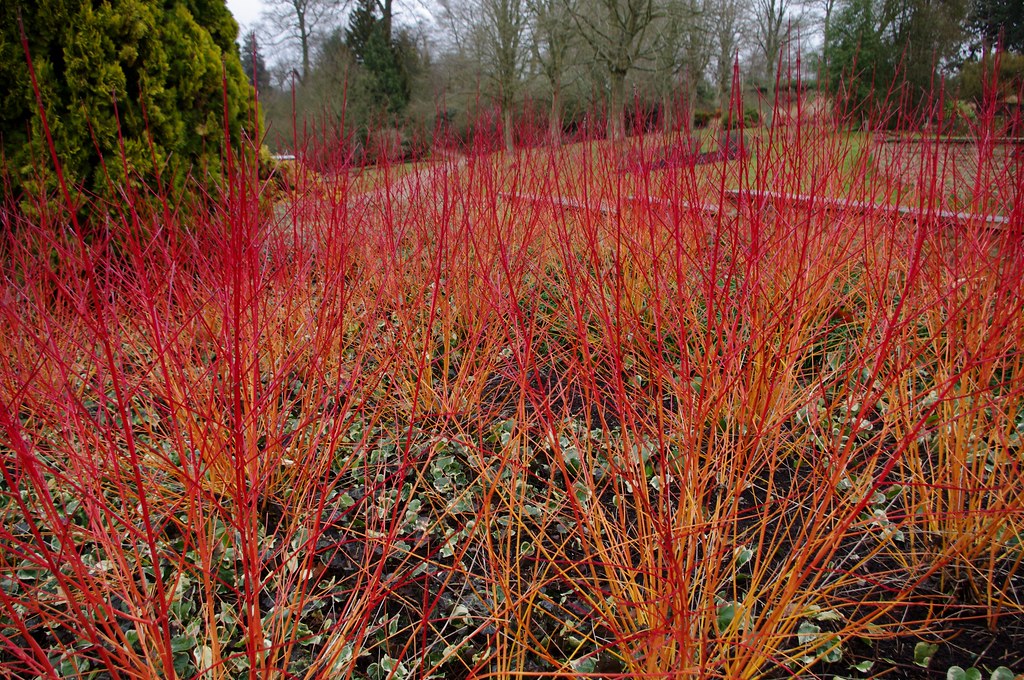As the days grow shorter in the year and the weather gets colder, many yards become gray and barren in appearance with little to no wildlife activity. Many gardeners still believe that plants can only provide beauty and function during the spring, summer, and fall; however, this is further from the truth when it comes to native plant species. In fact, in addition to the unique visual the plants can bring to a yard, many local animals rely on the presence of winter native plants to survive their stay in Pennsylvania. There are many online lists showcasing a variety of native plants that can fulfill the roles of landscape beauty and wildlife provision in the winter. Today you will be introduced to two different species from three different plant categories: shrubs, perennials/grasses, and groundcovers.

For shrubs, two suggested species to plant in the fall are Red Osier Dogwood (Cornus sanguinea; above image) and Winterberry (Ilex verticillata). Winterberry lives by its name with plump, red berries being present during the winter months. The berries are filled with nutrients, fats, and sugar for non-migrating species. Red Osier Dogwood provides a cardinal red color to the yard along with snow-white berries. For perennials/grasses, the two suggested species to plant in the spring before the next winter are Christmas Fern (Polystichum acrostichoides) and Tufted Hair Grass (Deschampsia caespitosa). Christmas Fern is one of a handful of native ferns that is able to survive the cold and snow while maintaining its green, clump form. Tufted Hair Grass is a powerhouse species where it provides seeds, shelter, and a bronze visual to the yard. Finally, we have two suggested groundcovers that should be planted in the spring to allow the development of their roots and leaves. Allegheny Pachysandra (Pachysandra procumbens) and Partridgeberry (Mitchella repens) provide an evergreen texture to the lowest levels of the garden. Partridgeberry also provides red berries to animals that find themselves sheltered safe amongst the leaves.
Here’s the short and sweet on the benefits to planting natives!
1. Beautifying Yard
- Bring color to the yard when most yards are gray and barren
- Bring texture to the yard when crooked trees dominate visuals
- Conduit for wildlife activity since they provide shelter and food
2. Provide to Winter Wildlife
- Important food source to survive winter, berries high in fat and sugar
- Important sheltering to brace against cold, material is collected or directly used as a shelter by some animals
3. Example Plants
A. Shrubs
- Red Osier Dogwood (Cornus sanguinea) – striking red color
- Winterberry (Ilex verticillata) – important food source
B. Groundcovers
- Allegheny Pachysandra (Pachysandra procumbens) – evergreen texture
- Partridgeberry (Mitchella repens) – important food source
C. Perennials and Grasses
- Christmas Fern (Polystichum acrostichoides) – evergreen texture
- Tufted Hair Grass (Deschampsia caespitosa) – bronze color
4. Tips and Reminders:
A. Perennials, grasses, and groundcovers should be planted in the spring
- Prior to the winter
- Allows spring and fall rains to water new plants
- Allows a warm summer to provide photosynthesis
B. Shrubs should be planted in the fall
- Prior to winter
- Allows one last drink
- Prevents the summer from stressing the root system or scorching the leaves

